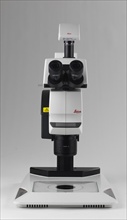Members Login

Channels
Special Offers & Promotions
Leica Microsystems Introduces New Transmitted-Light Bases for Stereomicroscopes
 Outstanding illumination in any situation: with its TL3000
ST (brightfield), TL4000 BFDF
(bright-/darkfield), TL4000
RC™ / TL4000
RCI™ (Rottermann Contrast™technology) and the new flat TL5000
Ergo (automatic, zoom dependent contrasting) transmitted-light bases, Leica
Microsystems is introducing a series of bases specially designed for a variety
of stereo and macroscope applications from documentation of single cells to
screening of whole animals.
Outstanding illumination in any situation: with its TL3000
ST (brightfield), TL4000 BFDF
(bright-/darkfield), TL4000
RC™ / TL4000
RCI™ (Rottermann Contrast™technology) and the new flat TL5000
Ergo (automatic, zoom dependent contrasting) transmitted-light bases, Leica
Microsystems is introducing a series of bases specially designed for a variety
of stereo and macroscope applications from documentation of single cells to
screening of whole animals. The Leica TL3000 ST transmitted-light base is the allrounder of the line. Its integrated, innovative halogen illumination system guarantees perfect conditions for viewing transmitted-light specimens. Thanks to its modest power consumption, base and specimen warming has been reduced significantly.
The Leica TL4000 BFDF darkfield base is suitable for observing stained amplitude specimens. With its rapid switching between bright and darkfield as well as its sensitive deflection mirror adjustment, the base is optimal for semi-transparent specimens such as embryos.
With their innovative Rottermann Contrast™ technology, the Leica TL4000 RC™ and TL4000 RCI™ transmitted-light bases permit refractive index variations to be displayed as differences in brightness. This relief effect provides a wealth of variations that allow the maximum amount of information to be obtained from any specimen. Together with the automated Leica M205 A or M205 FA stereomicroscopes, a computer and the Leica Application Suite (LAS) or the Leica Application Suite Advanced Fluorescence (LAS AF), many steps of the workflow can be automated for major gains in efficiency and time savings.
The new flat LED powered Leica TL5000 Ergo defines new standards in reproducibility and automatic contrasting. The homogenous field of view with its 65 mm diameter is optimized for single cells to whole animal examinations. The base has an integrated zoom dependent automatic aperture, which exclude diffuse light in brightfield to increase contrast. By displacing the light source out of the beam paths, perfect oblique illumination in Rottermann contrast™ appears. Furthermore, each contrast mode is coded and automatized, resulting in complete reproducibility and full controllability via the Leica LAS or LAS AF software.
The transmitted-light bases truly play out their strengths when combined with their accessories. The Leica mechanical stage, for example, noticeably simplifies day-to-day laboratory work with its low profile and precise X and Y control. Heating stages, adapters for micromanipulators and the entire Leica Live on Stage product line open a full range of applications previously beyond the capabilities of stereomicroscopes.
For more information visit www.leica-microsystems.com
Media Partners


